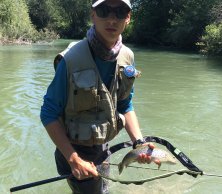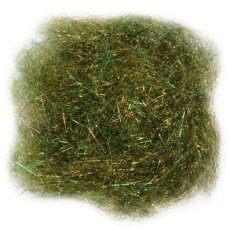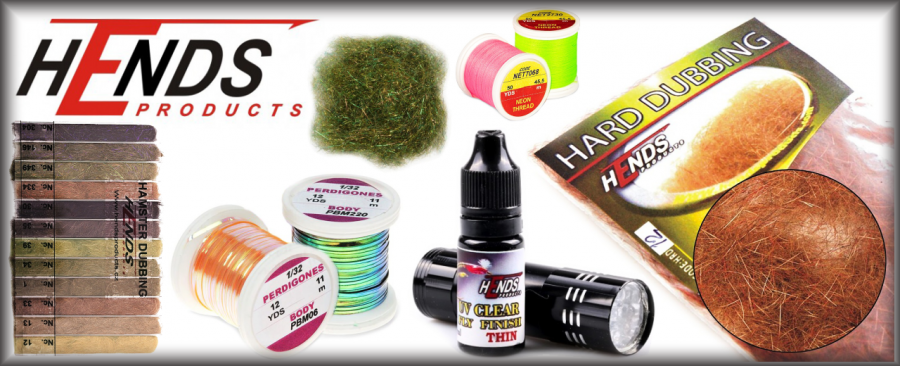Overview of new fly tying materials from Hends for 2020.
The beginning of the fly fishing season is fast approaching and it is the last moment to fill our boxes with freshly tied flies. Like every one of you, I like to discover new fly tying materials and think about how to improve even more my successful fly designs with them. For today's article I have prepared some new interesting materials from Hends. For more than 20 years Hends has been one of Czech leaders in the production of fly tying materials and tools, and the company (and the people behind) has definitely influenced the development of our modern fly fishing and fly tying.
Fur from hamster is a relatively new in fly tying. Hamster Dubbbing consists of a fine dense undercoat and ??? pesíky ???dog with a glassy sheen, which is rare in most hair. Its features resemble dubbing of American squirrel. The material is very fine and is the right choice for tying dry flies and nymphs collars however it can be used for dubbing entire body too. I personally like the material for tying the collar of more natural fly patterns and for making wet fly bodies. I have an entire color box of this material and there are some colors mixed with flash fibers that give the body a real charm. You can also purchase the material as zonker strip, called Superfine Zonker Strip, or all skin (Hamster Pelt), from which you can then make your own dubbing to your liking, or cut into zonker strips with the diameter you require.
Flash material that is tuned into peacock feathers. There are more similar materials in our market, but most of them are very rough and they are not working well. Peacock Dubbing has fibers of the same coarseness as the popular Spectra Dubbing. A lot of similar materials are rather a mixture of different colored fibers and I consider Hends Peacock Dubbing much better imitation of natural peacock feathers compared to some other products. Use is mainly for tying bodies and collars, or you can use several fibers to revive any of the natural dubbing materials.
Highlighting thread that are used for creating tags, thoraxes or ribbing. They are produced in twelve signal shades and all react to UV light. Fish perceive light reflection at a lower wavelength, so they can also perceive UV radiation. For materials that reflect UV light, you may notice that they begin to “glow” when illuminated by a UV lamp. For the material I appreciate the thinner fiber diameter, because less is sometimes more and there is definitely no need to exaggerate with the size of the tags or tips. If you need a thicker tag, it is sufficient to fold the thread several times to the required thickness.
Body Quill Multicolour
Body Quill is material known to all lovers of tying small ephemera patterns. It is a thin translucent tinsel, spun by thin synthetic fibers. The tied body is translucent and, due to the gradual layering, the body changes from light to dark. The new design is two-color, so you can tie a two-color body with a color gradient from one tinsel without having to use more materials.
Before enthusiastically plunging into the tying withthis material, I have to outline a few essentials with which to use this material. In order for the body to have a properly translucent structure, it is necessary to use a white binding thread. To make the body as thin as possible, remove the reinforcing fibers and fold the material into two halves for faster tying. With the new version of multicolour Body Quill, it is important to fold the material half where the material has a light section. The rest will be darker and you will achieve the aforementioned color gradient.
High iridiscent (changeable) thisels that are primarily intended for tying Perdigon nymphs, but they can also be used for other types of flies. They are produced in several interesting shades. The main difference compared to other tinsels is in multicolored gloss. Because of their use on Perdigons, the tinsel effect is most interesting after being embedded in UV glue. Each color behaves slightly differently after the glue applicatoin. Some shades create a dark articulation on the body, due to the otherwise colored edges. Others will create a reddish surface, etc. It is important to test the color of the base material (tying threads), the basis is black and white tying thread). Thus, a single Perl Perdigon Body can create a completely different body color due to a change in the tying thread. You can choose from two widths 1/69 for small flies and 1/32 for larger flies.
Coarser natural dubbing, is made from a mixture of multiple types of fur. The material contains both finer undercoat and natural ??? pesíky. It is best used for tying larger dry and wet flies or streamers. The material is for me the right choice for tying large pupas and dry caddies. After combing, the material can nicely mimic the insect legs.
Fish Heads
Finally, I will introduce you a novelty, especially for lovers of predator hunting, which will soon be available for sale. We are talking about plastic streamer heads that give your streamer a realistic look. The Hends company was the first to come up with the colors of these heads, and they are also available in four sizes. Another big plus is that you will not have to spend too much time shaping the head of UV glue or epoxy resin, so you save time and nerves. Secure the head to the hook with superglue, eyes to the head as well. If you are afraid that your eyes will not last long on the streamer, cover them with UV resin.
Tying instructions are in the below video from Fulling Mill:
I hope that he will not be afraid to experiment with new materials at a vice and that flies from these materials will bring you a lot of experience and fun by the river!



















